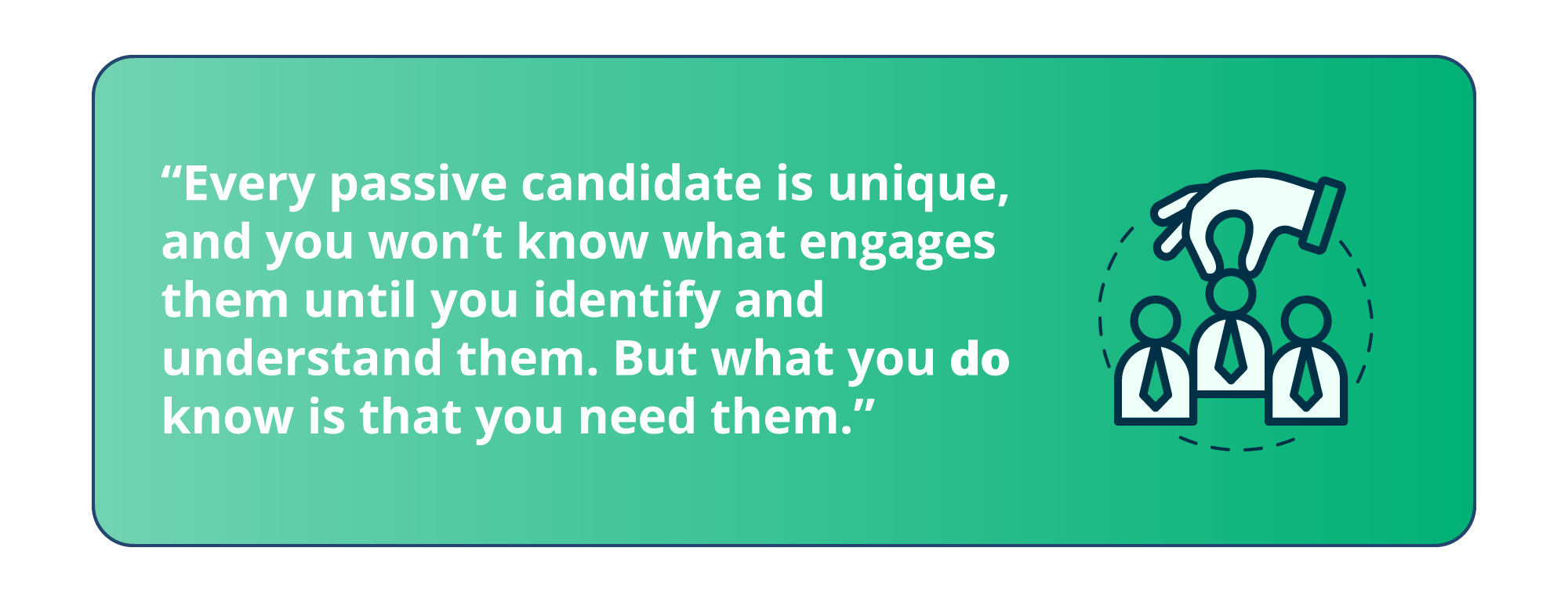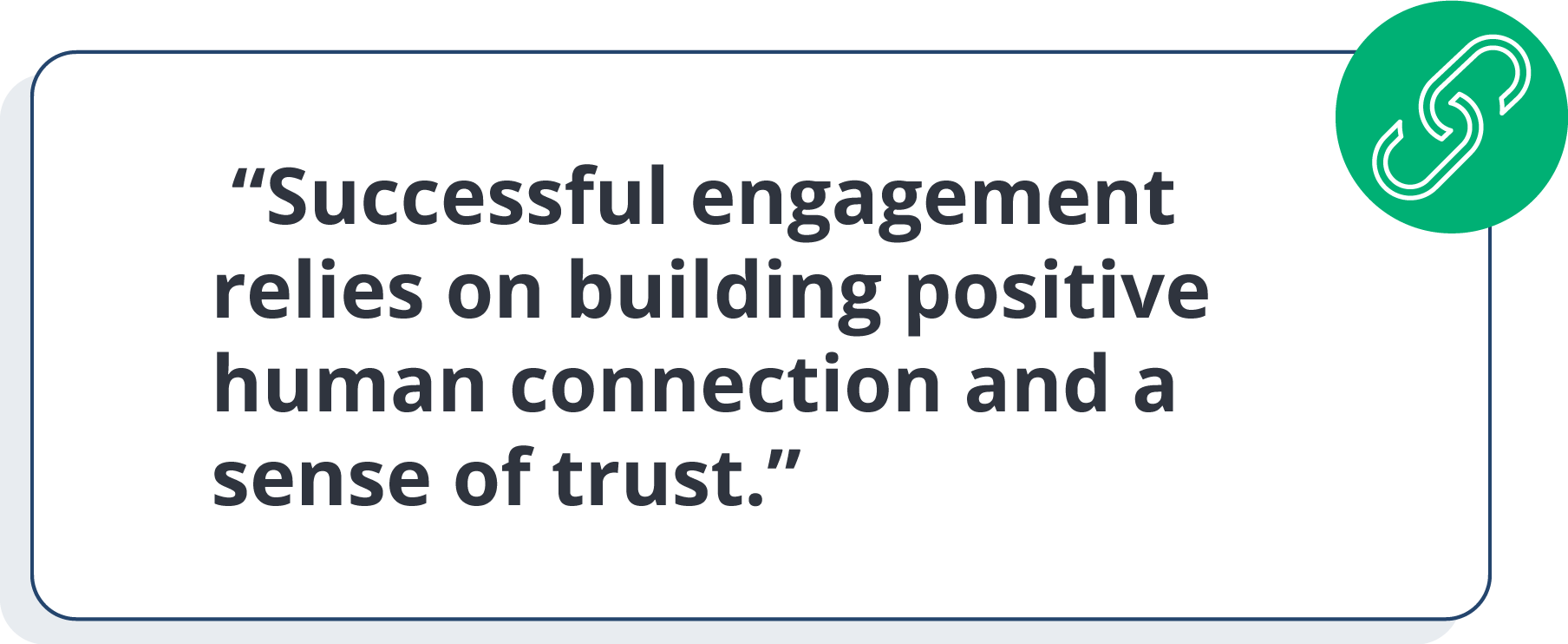It’s easy to spot a happy, healthy hiring professional. Inevitably, they’ll be that possibly-slightly-smug person sitting on a rich, productive talent funnel powered by an endless supply of quality, passive candidates. What’s their secret, you ask? It’s all about engagement.
Engaging passive candidates is continents apart from engaging active ones. The same ideas and efforts won’t cut it. So let’s take a closer look at some best practices to help supercharge your passive candidate engagement strategy.
Passive Candidates = Most Of Us
Passive candidates are working people who are not currently looking for another job. They’re simply active candidates who haven’t yet been guided to the right opportunities. Within that definition lies a ton of nuance. Passive candidates may self-identify as:
- True passives. People who love their jobs and have no thoughts of moving.
- Fence-sitters. A rising number of candidates are open to new opportunities. With an encouraging nudge and an easy application process, they might jump.
- Careerists: People who are happy where they are for as long as it serves their career ambitions. At the right time, they’ll be looking to move up or out.
The passive talent pool is huge. Estimates vary, ranging from as high as 70% to as low as 39% of the total global talent pool. However you do the math, ignoring the passive talent pool would be a colossal mistake.

Why You Need Passive Candidates
Given that passive candidates vastly outnumber active job-seekers, the global passive talent pool is a whopping, untapped resource waiting to fill your organization’s empty roles.
The people with the right skills and experience for your roles will be there. It’s not just about satisfying hard-to-fill role demands, however. Your ability to successfully engage passive talent will:
-
- Help you build and maintain a healthy talent pipeline.
A healthy pipeline allows you to build resources for future hiring, anticipating needs ahead of time and insuring you against staffing shortages. - Keep you out of candidate wars.
Let other recruiters compete for shrinking numbers of top active talent while you keep a steady supply of passive candidates warm in your carefully curated pipeline. - Help you create a stellar candidate experience for all candidates.
Passive candidates stay engaged because of personal connections. Practicing this helps you understand more about building positive relationships with all candidates. - Help you improve time-to-hire.
The effort you’ve made to earn the trust of passive candidates pays off in reduced time-to-hire. You know what they’re looking for, and they’re familiar with you and your system.
- Help you build and maintain a healthy talent pipeline.
Passive candidates may be open to new roles, but their level of openness depends on how well you engage them.
Engaging Passive Candidates
Active candidates love you because you have that awesome job they’re after. But when you’re trying to engage passive candidates, you need to ditch your ego because they don’t need or love you (yet). They’re (mostly) happy where they are.
The candidate experience is just as important to passive candidates as active ones, however. Engaging a passive candidate is all about building (maybe long-term) relationships through personalization, connection, and making everything very, very easy.
Personalization
Information and understanding are key to truly engaging personalization. You’ll need to get to know the person, and that means researching to understand:
- Their skills and experiences.
- What they value – and what they don’t.
- Their personality.
- Their interests.
- Connections – people, hobbies, experience – between you and your candidate.
Gen Z, especially, requires deeper levels of personalization and the personal touch. Be aware of higher (or perhaps louder) levels of employee activism within this subset of passive candidates. Recent research, however, suggests that Boomers, not Zoomers, are more purpose-driven candidates.
Use AI as a strategic tool to collate a pool of potential targeted talent. Visage’s platform, for instance, empowers you to find hard-to-reach passive talent and unearth useful insight on your candidates, which you can use to start personalizing your approach to them.
Before you connect with your target, it’s useful to:
- Think like a passive candidate.
This is easy because, unless you’re actively looking for a new employer, you are a passive candidate. If approached by a talent sourcer, how would you like to be treated? What’s important to you? What would put you off? - Use your job market expertise.
You know today’s market, but your passive candidate doesn’t, especially if they’re a true passive who hasn’t checked the job market in years. Use your expertise to paint a picture of new possibilities for them. Plant a seed. - Refine and redefine niche job roles.
Make job descriptions more attractive to the best-fit passive candidates by aligning them with their expectations or desires.
Once you have a basic understanding of your target candidate, it’s time to connect.
Connection
Successful engagement relies on building positive human connections and a sense of trust. It’s important that your candidates don’t feel like they’re being processed, like they’re just another number for your recruitment stats.

Use AI
Here’s how AI can help you reach the candidate numbers you need for a healthy pipeline while maintaining that important personal touch:
- Use customizable templates. A one-size-fits-all email won’t work. Create a range of customizable templates as a basis for your targeted email campaigns so they’re ready and waiting for you to personalize and schedule. (Too busy to create your own? We’ve created a bunch of fully customizable templates designed for targeted engagement, all ready for your personalization.)
- Don’t forget to customize your follow-up emails. It’s tempting to focus all efforts on the first email, but we’ve found, statistically, we see more responses from second or even third emails.
- Get the cadence right. Don’t be a pain with a spamload of emails. If you’re not sure how often to check in with a candidate, ask them. Then schedule your follow-up communications accordingly.
Make It Personal
Build credibility and trust with your candidate by:
- Including your social media profiles. For deeper authenticity and credibility, add your LinkedIn and other social media profile links to your email signature. Our clients find that this increases response rates and trust, as candidates can see that you’re a real human person.
- Name-dropping. If you’re professionally connected to one of their connections or have worked at their company or another one they’d know, mention it.
- Making links. Mention any common interests. Maybe you’re both runners, or you both volunteer with animals, or root for the same sports team. Having something in common will show candidates that you’re just like them.
- Show them they’re not a number (without being creepy). During your research, what stood out to you about your candidate—a skill, an achievement? Let them know what specifically impressed you.
- Asking questions. Here’s where you seek to understand more about the candidate: What’s important to them? What might be holding them back from moving on? It’ll help you find and refine future opportunities for them.
- Sharing next steps. Perhaps it’s just asking permission for a chat, or to contact them in six months’ time.
Say thank you or send an acknowledgment if a candidate takes any step forward, no matter how small.
Making It Easy
Don’t give your passive candidates more work. Make the process as frictionless as possible for them. When it’s easy for them to stay connected with you, they won’t drop out because of frustration or annoyance. Reduce barriers by:
- Avoiding multiple steps and constant form-filling.
- Eliminating repetitive form fields or requests.
- Communicating their way – by mobile, through social media, email, or phone. It’s their choice.
- Giving encouragement and positive feedback for every step forward.
Passive Candidate Engagement: The Visage Way
Whatever hiring challenge you’re facing, the passive talent pool contains the solution. The fun part is identifying target passive candidates and getting them excited about new opportunities. Visage helps with both.
We understand the challenges of passive candidate engagement, so we designed the Visage platform so our clients can easily identify and turn thousands of passive candidates into warm leads, fast.
We pride ourselves on frictionless comms and enriched templates for maximum engagement, and we add a ton of automation and insight to keep your campaign on track and your pipeline packed with passive talent.
Want to find and engage hard-to-reach talent today? Start your campaign now.

Director of Sourcing Operations at Visage, Evelyn has experience in agency, RPO, and in-house roles spanning 12 years in the recruitment industry. Evelyn has built and oversees a 4000-member global freelance sourcing community. Every Christmas in Ireland, she enjoys putting up her THREE Christmas trees.

